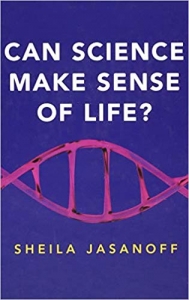Review of the Power of Technology by Sheila Jasanoff
In Tin Science Make Sense of Life? , Sheila Jasanoff questions whether the scientific capacity to dispense life at the molecular level should also give science the authorization to ascertain what life is for. Exploring various cases to show how (techno)scientific knowledge embeds and is embedded in our social practices, identities, norms, institutions and ways of speaking , this book is a salient introduction to those new to Jasanoff's 'third-wave' of Scientific discipline and Engineering Studies (STS) scholarship, recommends Anna Nguyen .
Tin Science Make Sense of Life? Sheila Jasanoff. Polity. 2019.
 Find this book:
Find this book:![]()
On 31 March 2019, at a workshop for the Canadian Network for Scientific discipline and Democracy in Ottawa, Pforzheimer Professor of Scientific discipline and Technology Studies (STS) Sheila Jasanoff gave a keynote presentation in which she reflected on co-product equally a method and her own expectations when introducing it nearly twenty years ago. Reminding the audition that co-product is not quite a method but is instead an 'idiom', she cautioned against using it as an caption or fully developed theory. Rather, it is a style of thinking and talking virtually the ways in which the natural and social orders are produced together.
Jasanoff's newest book, Can Science Make Sense of Life?, is an extension of her scholarship in STS, an interdisciplinary field that came into being through the seminal works of sociologists, philosophers, historians and political theorists, amongst others. To some, it may seem that STS is a very niche academic field, 1 that highlights the textile instantiations of science and applied science in society. Indeed, this is a core concern in the catechism, only the emphasis is where materialist STS scholars and Jasanoff and her more than humanist peers differ. In elaborating co-product and sociotechnical imaginaries, Jasanoff explicates that (techno)scientific knowledge embeds and is embedded in our social practices, identities, norms, institutions and ways of speaking. Considering the technical and the material are already woven in social formations of life, STS scholars demand not focus on only the technics, the ontological or the material but the complete sociotechnical pic of how we wish to alive in society.
In the prologue, Jasanoff introduces her main objectives by rhetorically gesturing at the championship of her new book. 'What is life?' and 'what is life for?' (9) are the broad moral questions she targets by examining science as a metaphorical tool in ongoing discussions of expertise and legitimation. Specifically, Jasanoff looks at biology and its impact on how we understand life. The foundational biological metaphor represents the human factor as the book of life. The case study of biology and biotechnology reveals how each has securely impacted constitutional understandings of human subjects and the ways in which nosotros cull to be governed, themes that she explores in the side by side 7 chapters.
The image of Paul Gauguin's 1897 painting D'où Venons Nous/Que Sommes Nous/Où Allons Nous (Where Practice We Come up From/What Are We/Where Are We Going) serves to illustrate the recurring questions that Jasanoff introduces in the prologue. Gauguin's turn-of-the-century masterpiece, as Jasanoff describes, coincided with the revolutionary years of modernistic biology during the nineteenth century (14). Advances in science, specifically biological science, afforded some other type of material language that shaped our agreement of life and what it means. Like any kind of specialised linguistic communication, the language of science gradually became both a descriptive and prescriptive forcefulness (15). Jasanoff points out that science does not explicitly claim to completely respond all of the questions she poses; yet, biology and biotechnology are regarded as of import forces to brand sense of life. Referencing American physicist's Evelyn Fox Keller's note on 'the biological gaze', Jasanoff empirically discusses how the rhetorical uses of science in society are linked with the privatisation of scientific progress. Metaphors of the coded alphabet of Deoxyribonucleic acid (adenine, thymine, guanine, cytosine) and Vannevar Bush's' 'endless borderland' become driving forces in the institutionalisation of scientific discipline (22-24).
 Image Credit: (jesse orrico unsplash CCO)
Image Credit: (jesse orrico unsplash CCO)
Affiliate Two continues this thread into the twentieth century. Jasanoff observes that scientific discipline has tried to organise and directly life in ii ways: how to manipulate it and how to turn a profit from it (37-38). The ability to examine DNA and other minor structures and processes became entangled with society'southward concerns and desired futures, shifting from the lab to the marketplace. And though we have seen tweets and papers concluding with the claim that 'science is political', few academics have attempted to grapple with the continual myth of science as pure and untouched from political and capitalistic forces (38). If 'bad' science is invoked, it is because money and politics are characterised equally corrupting influences; most of the fourth dimension, science is largely seen equally autonomous and scientists as intelligent and curiously driven plenty to self-regulate. Although Jasanoff rarely uses the academic term 'technoscience', she subtly gestures to the technological innovations of science as the tools that enable 'the eureka moment' (48). This is reminiscent of the fabulous ethnography of the materialist scientist obsessed with paperwork and objects on their desk in Bruno Latour and Steve Woolgar's Laboratory Life. Like their constructivist parable, Jasanoff and others tell us that STS should grapple with the political, social and material forces of science studies. Otherwise, we have not even so moved on from the myth of science in modernity.
Capacity Iii and Four remind us of Jasanoff'due south ain academic expertise in law. She describes how the Asilomar meeting in 1975 and the cosmos of the NIH Recombinant Dna Advisory Committee (RAC) were instances when police force, science and society intersected. The Asilomar meeting was one of the first deliberations on the topic of lab-created biological entities, which raised concerns about who is categorised as human or what counts as a human subject (68) and what the opinions of the public represented. These early regulatory activities did not go unchallenged. In Foundation on Economic Trends v. Heckler, the US Court of Appeals for the DC Excursion concluded that the NIH had not considered environmental impacts before releasing engineered life forms (75-76). Though Jasanoff notes that all three judges on the panel shared similar concerns well-nigh the conduct of NIH, this ramble motion did non crusade other scientists, or scientific discipline-minded academics, to reflect upon concerns regarding accountability and the commonwealth. In an essay in a Yale law journal, co-organiser of the Asilomar meeting Maxine Singer fabricated a technocratically-charged suggestion that only scientific judgment should be accounted for in deciding whether research should proceed or be stopped (76). In the aforementioned essay, Vocaliser proposed that, to prevent like lawsuits, lawyers should be required to demonstrate basic knowledge of scientific languages in court and even on LSAT exams (78).
Some other instance that Jasanoff explores is the story of Henrietta Lacks, most famous for its illustration of racial politics in biomedicine and of constitutional responsibility (86-88). The argument that 'cells are united states' calls into question how far science can go in using biological materials and how to take the scientific promises of societal and technological progress. Further, in Chapter Four, Jasanoff turns her attention to recent and ongoing concerns: genetically modified organisms (GMOs), ballgame, Roe v. Wade, the 14-mean solar day rule and stem cell research. Reiterating a comparative analysis between the US, Uk and Germany, every bit we saw in Designs on Nature, she notes that the 14-day rule appealed to different national commitments to protecting lives and man values and norms of public reasoning. The almost recent instance of human genome editing in the Clustered Regularly Interspaced Short Palindromic Repeats (CRISPR) is just one of the iterations of the 'what is life' question, a case that Jasanoff as well cites in Chapter V.
In Chapters Five through Seven, Jasanoff returns her attending to the broader aspects of the part of language in science. Citing Lugwig Wittgenstein's 'linguistic communication games' and Michel Foucault's 'biopower', Jasanoff reminds us that science has go an origin story that has claimed control over the definition of life (121). The devices of language—models and metaphors—are some ways in which biologists have tried to understand life (173-74). Jasanoff herself only wants readers to ponder how science has come to be significant in questions of life and its meaning. For those who recollect scientific discipline has been successful in making sense of life, the Jasanoffian follow-upward question is 'how has information technology fabricated life meaningful?' and how has this meaning been shared across many communities? Though rhetorical, in that location is no clear respond to this question, as Affiliate Four'due south championship, 'Life in the Gray Zone', indicates.
For those who have long followed Jasanoff's scholarship, this volume echoes her previous works and her important contributions in STS literature. Edifice on her reliance on discourse, her final chapter, of form, ends with a humanist reflection. She emphasises that this book is very much nigh how science should be a communicable exercise not simply to a technocratic-minded customs or commission, but to all stakeholders. For those new to her 'third-wave' of STS scholarship, Jasanoff's book can serve as a salient introduction to this approach, expressed through recurring aphorisms and parables.
- This review originally appeared at the LSE Review of Books.
Please read our comments policy before commenting .
Note: This article gives the views of the authors, and not the position of USAPP– American Politics and Policy, nor of the London Schoolhouse of Economic science.
Shortened URL for this post: http://bit.ly/2TEoikD
Near the reviewer
Anna Nguyen – INRS Montreal
Anna Nguyen is a PhD student at L'institut national de la recherche scientifique (INRS) in Montreal, Canada. Her research analyses discourses of innovation, novelty and expertise in the context of nutrient literature and scientific nutrient reporting.
Source: https://blogs.lse.ac.uk/usappblog/2019/08/18/book-review-can-science-make-sense-of-life-by-sheila-jasanoff/
0 Response to "Review of the Power of Technology by Sheila Jasanoff"
Post a Comment